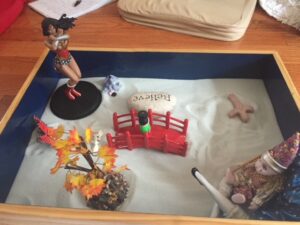
There are many different ways to process trauma in therapy. One intervention, sandtray therapy, provides a non-verbal, less intrusive way for clients to process trauma. Sandtray is often misunderstood. Most associate it with play therapy and children, but the benefits of sandtray run across the whole developmental span. Children, adolescents and adults have all found insight and healing through the use of sand in therapy. Although the way children and adults process the sand scene may look different, this modality provides a way to externalize memories that may be painful or hurtful, reframing the experience and bringing healing. The sand tray along with the trained therapist provides a safe and contained space where the client has the opportunity to see their world in a new way. This less intrusive modality helps integrate the left and right side of the brain, incorporates the body, which also holds trauma, and uses symbols to reflect the internal personal stories that are often too difficult to talk about.
Sandtray and the Brain
What makes sandtray therapy so powerful is the fact that it helps the client integrate the whole brain. In a healthy brain the right and left sides of the brain, which are connected, communicate with one another. The left brain is analytic, logical, and holds our language center. The right brain is the center of our emotions and nonverbal communications, is more intuitive, and is creative. The right brain is also where we store our sensory memories of sight, sound, smell, and touch. When we experience trauma our executive function shuts down. The communication between the right and left brain goes offline. So, what would normally be possible in talk therapy is no longer possible. Trauma survivors do not have the words to express or understand what happened to them, but through the use of sandtray therapy, play therapy, and the expressive arts that tap into the right brain, they can begin releasing the internal stories that have shaped how they feel and experience the world.
Traumatic experiences influence not only how we see and experience the world, but also impacts how our body responds. The trauma is encoded in our body. In an effort to protect we may push down painful memories but are unable to stop our body from responding. Our implicit memories are triggered from something we see, hear, touch, taste, or smell, which causes us to fight, flee, or freeze. Panic attacks, a rapid heart-beat, and somatic pain are all reactions that can happen when memories from traumatic or painful events are triggered. Even thinking about the trauma can bring up these intense reactions. The sand tray provides a safe space to externalize and contain the hurt, shame, and pain that was too difficult to remember or to explain with words. The miniatures represent symbols and metaphors of the client’s world, experience, and feelings. The therapist is present to keep the client safe and to be a witness to hear the stories without judgment or prying, allowing the client to explore and share as they are ready. The healing happens as the client is able to resolve conflict, find new meaning, heal past hurts, and learn self-acceptance. Touching the sand can have a calming sensory effect and the placement and removal of objects in the sand help incorporate the body as well as the mind in therapy.
What does Sandtray Therapy look like?

When presented the option of sandtray, you are offered the use of a wooden tray filled with sand. Some trays are circular and others are rectangular. The sand chosen is a different quality from the sand used in sand boxes and comes in different colors. In addition to the tray and sand the clients have access to miniatures that they use to tell their story. The miniatures vary but will include people, mythical creatures, animals, elements in nature, and other objects. Clients may work in silence or they may tell the story being created as they work in the sand. Many children act out a story as the figures move and interact in the scene. Although the therapist may provide a directive, the client leads the process, selecting the figures and placing them in the sand. The therapist is present to provide safety and if the client is interested, the therapist can assist them in exploring and processing the scene.
Sandtray Resources
This is just a glimpse into the world of sand. For more information you might like to check out these resources:
- Sandtray: Playing to Heal, Recover, and Grow by Roxanne Rae
- Sandtray Therapy: A Humanistic Approach by Stephen Armstrong
- Jungian Sandplay Therapy by Barbara A Turner, PhD
Resources on the Brain
- Dan Siegel’s Hand model of the Brain
- Hand model of the brain for kids
- The Body Keeps the Score: Brain, Mind, and Body in the Healing of Trauma. By Bessel Van Der Kolk, M.D.
Interested in learning how your child might benefit from Sandtray Therapy? Reach out to us at Milestones Counseling & Consulting Services. Call (443) 574-4295 to schedule an appointment today with one of our talented and compassionate counselors.
